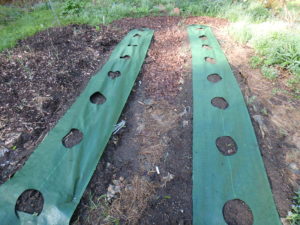It’s (Almost) Time to Plant Tomatoes
Maybe you’ve already planted your tomatoes. I have not. I’m waiting until June 10. By then, even in my cold Zone 4 garden, I know there will be no more frost and the ground will be above 60 degrees. And the stars, moon and planets will be aligned from June 10 to 12 to promote success for fruits, one of the 4 categories listed in the Stella Natura calendar, a biodynamic guide that I follow (www.stellanatura.com).
I start my seedlings indoors in April, and I’m in no rush to put my babies outside in the cold, rainy world that I’ve been seeing in May. And even if you have planted yours, I bet mine will catch up with yours. Tomatoes hate cold feet and a few days of chilly rain will make them cranky – and slow their growth.
Before my tomatoes and other plants get in the garden they get “hardened off.” If you are new to gardening, that just means I introduce them to the sun and wind over a period of time. An hour at first, or a morning on a north-facing deck. Later 4 hours of afternoon sun, and finally, if the temperature will stay up above 50 all night, they have a sleep over outside, but out of the wind. All this just means when they go in the ground, they will not be shocked.
Do you buy your seedlings? Ask at the garden center if the plants you buy have been hardened off. Even Brussels sprouts can be damaged if they have never been hardened off and go right in the garden.
I want my tomatoes to have lots of vigorous roots. To help ensure this I pinch off most leaves on the stem, leaving just those on the very top – sort of like a cartoon palm tree. Then I bury that stem and it develops lots of extra roots. Sometimes I just plant the root ball and stem down deep. Other times I plant the tomatoes sideways: I make a space for the root ball, and a little trench for the stem. I cover all that, and turn up the stem at the top so the few remaining leaves are barely above the soil line.
Leggy broccoli can be planted deeply, too, to help it stay erect, and to develop more roots. Legginess is common for seedlings started indoors that have been a little light-starved, and I think all can be planted deeply, but only have done this with tomatoes and broccoli.
What else gets extra care and a late planting date? Eggplants, peppers, cucumbers, squash of all types and basil. They all like hot climates, and come from them. I did plant seeds in May including peas, spinach, carrots, beets, parsnips, cabbage and lettuce. Those are all doing fine. Actually peas went in a bit late and are not up yet for me at the time of writing.
Peas can be very slow to germinate, and can even rot in the ground if we get a lot of cold rain. I plant most everything in raised beds, in part, to get the soil to warm up early and to dry out better. My garden is near a stream and we have a high water table, so raised beds help. I just mound up the soil from walkways and add compost to get nice raised beds.
Peas and beans of all types can benefit by being inoculated with a bacterium powder that is sold in garden centers and at my feed–n-grain store. Peas and beans are legumes, a group of vegetables with nodules in their roots. If these contain rhizobium bacteria, they take nitrogen from the air and “fix” it so that it stays in a form useable by plants. Free fertilizer, if you will.
Contrary to “rural legend”, the nitrogen fixed by peas and beans does not improve the soil very much. I always thought the rhizobium bacteria were pumping nitrogen into the soil. In fact, most of the production is used by the plants themselves.
The nodules that contain the bacteria are generally pink or reddish when producing well, and can be as big as a pea. When you pull a pea or bean plant, look at the roots. If you do not see lumps of nodules, be sure to introduce the bacteria next year (it may or may not be present in your soil naturally).
A few words about mulching: do not mulch your plants right away. Wait until the soil is very warm – 60 degrees or more – before mulching. Yes, the mulch will keep down weeds and hold in moisture, but it will also prevent the sun from warming the root zone.
I know gardeners that like to put down black plastic to kill weeds and add heat to the soil. I have used it –particularly for growing watermelons and pumpkins – but don’t like it. Most plastic lasts just one year and then has to go to the landfill. It’s not a sustainable practice.
I do like using woven landscape fabric, however. A Vermont company, GardenMats, produces rolls of fabric with pre-cut holes spaced for specific crops. These mats keep down weeds but let air and water pass through. The rolls are 4 feet wide, but I slice mine down the middle as my raised beds are only about 30 inches wide. I put leaves or mulch hay around the edges and in my walkways.
New England weather is never predictable, so I tend to plant later than many gardeners. Usually I am glad I did.
Read Henry’s blog at dailyUV.com.




